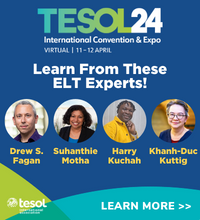Keeping Up With Styles
For good reason. Language, both first and second, acquisition in particular is accelerated by the multimedia channels made available through new technology. Now, we are also starting to appreciate the opportunities it offers for differentiated instruction to cater not only to multi-level classes but also to individual learning styles.In his 1983 book Frames of Mind, Harvard professor Howard Gardner originally identified seven intelligences (or learning styles) that we all possess, to which three new intelligences have recently been added. Because our understanding of the brain and human behavior is constantly evolving, the number of intelligences is expanding. Gardner claims that we all have all the intelligences, but that no two people are exactly alike and by understanding a student’s strengths and weaknesses in each intelligence, we can help students become more successful. He adds that integrating multiple intelligences into the classroom requires addressing individual differences and providing a range of activities and experiences to facilitate learning. Technology can be used to facilitate learning in each intelligence area. The key is to provide the most suitable learning environment for students according to their particular balance of intelligences or styles.
A couple of years ago, Gardner clarified his position on technology’s effect on literacy, “At the start of the 21st century, there’s a dizzying set of literacies available — written languages, graphic displays and notations. And there’s an even broader array of media — analog, digital, electronic, hand-held, tangible and virtual — from which to pick and choose… I don’t worry for a nanosecond that reading and writing will disappear. Even in the new digital media, it’s essential to be able to read and write fluently… I also question the predicted disappearance of the material book… The convenience and portability of the book aren’t easily replaced.” (“The End of Literacy? Don’t Stop Reading” printed in the Washington Post, February 17, 2008.)
Investing in technology does not preclude support for more traditional means of education like books, libraries, and librarians. Gardner’s position and research by other pioneers like Dr. Rita Dunn shows us that the wider the range of teaching methods and materials available the more likely students are to find the methodology that suits their particular style or intelligence. To best serve the array of learners in our schools we must retain the tools which work while embracing and experimenting with new teaching formats that reflect our society’s development.
As John Dewey, the 20th century philosopher and educational reformer said “If we teach today as we taught yesterday, we rob our children of tomorrow.”
IN THIS ISSUE:
Insuring Adventure
Harnessing Technology
Lance Knowles recommends educators train to use technology to improve language learning efficacy
Weaving Culture into the Web
Fred Dervin explores how teachers can use the Living Web (Web 2.0) for intercultural education in language learning and teaching
Video Gaming: The New Free Voluntary Reading?
Kenneth S. Horowitz finds a parallel between the use of video games and Krashen’s theories of Free Voluntary Reading and Free Voluntary Surfing
Experimenting with Technology
Language Magazine Product Review of Language Labs
Kate Sommers-Dawes marvels at Costa Rica as a Spanish immersion destination
Last Writes
Richard Lederer has a dictionary for teachers
Plus all the latest news in language learning technology, book reviews, and source information on language funding






